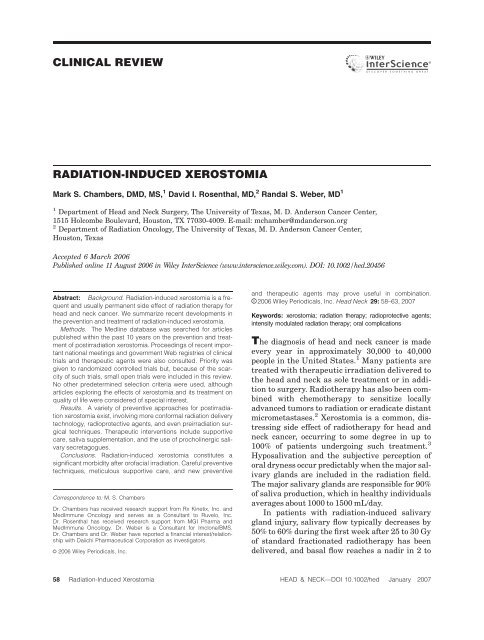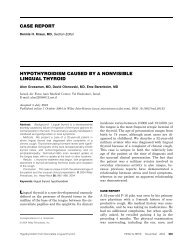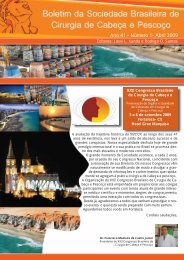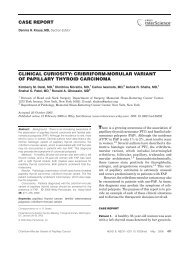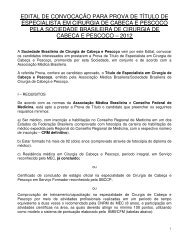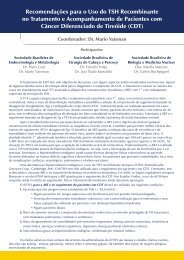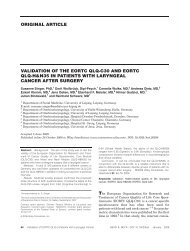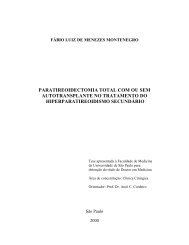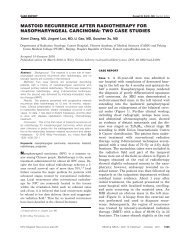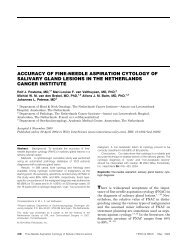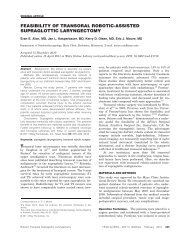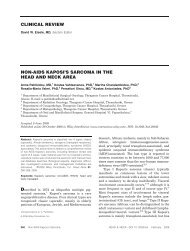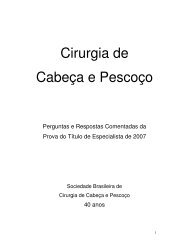Radiation-induced xerostomia
Radiation-induced xerostomia
Radiation-induced xerostomia
You also want an ePaper? Increase the reach of your titles
YUMPU automatically turns print PDFs into web optimized ePapers that Google loves.
CLINICAL REVIEW<br />
RADIATION-INDUCED XEROSTOMIA<br />
Mark S. Chambers, DMD, MS, 1 David I. Rosenthal, MD, 2 Randal S. Weber, MD 1<br />
1 Department of Head and Neck Surgery, The University of Texas, M. D. Anderson Cancer Center,<br />
1515 Holcombe Boulevard, Houston, TX 77030-4009. E-mail: mchamber@mdanderson.org<br />
2 Department of <strong>Radiation</strong> Oncology, The University of Texas, M. D. Anderson Cancer Center,<br />
Houston, Texas<br />
Accepted 6 March 2006<br />
Published online 11 August 2006 in Wiley InterScience (www.interscience.wiley.com). DOI: 10.1002/hed.20456<br />
Abstract: Background. <strong>Radiation</strong>-<strong>induced</strong> <strong>xerostomia</strong> is a frequent<br />
and usually permanent side effect of radiation therapy for<br />
head and neck cancer. We summarize recent developments in<br />
the prevention and treatment of radiation-<strong>induced</strong> <strong>xerostomia</strong>.<br />
Methods. The Medline database was searched for articles<br />
published within the past 10 years on the prevention and treatment<br />
of postirradiation <strong>xerostomia</strong>. Proceedings of recent important<br />
national meetings and government Web registries of clinical<br />
trials and therapeutic agents were also consulted. Priority was<br />
given to randomized controlled trials but, because of the scarcity<br />
of such trials, small open trials were included in this review.<br />
No other predetermined selection criteria were used, although<br />
articles exploring the effects of <strong>xerostomia</strong> and its treatment on<br />
quality of life were considered of special interest.<br />
Results. A variety of preventive approaches for postirradiation<br />
<strong>xerostomia</strong> exist, involving more conformal radiation delivery<br />
technology, radioprotective agents, and even preirradiation surgical<br />
techniques. Therapeutic interventions include supportive<br />
care, saliva supplementation, and the use of procholinergic salivary<br />
secretagogues.<br />
Conclusions. <strong>Radiation</strong>-<strong>induced</strong> <strong>xerostomia</strong> constitutes a<br />
significant morbidity after orofacial irradiation. Careful preventive<br />
techniques, meticulous supportive care, and new preventive<br />
Correspondence to: M. S. Chambers<br />
Dr. Chambers has received research support from Rx Kinetix, Inc. and<br />
MedImmune Oncology and serves as a Consultant to Ruvelo, Inc.<br />
Dr. Rosenthal has received research support from MGI Pharma and<br />
MedImmune Oncology. Dr. Weber is a Consultant for Imclone/BMS.<br />
Dr. Chambers and Dr. Weber have reported a financial interest/relationship<br />
with Daiichi Pharmaceutical Corporation as investigators.<br />
VC<br />
2006 Wiley Periodicals, Inc.<br />
and therapeutic agents may prove useful in combination.<br />
VC 2006 Wiley Periodicals, Inc. Head Neck 29: 58–63, 2007<br />
Keywords: <strong>xerostomia</strong>; radiation therapy; radioprotective agents;<br />
intensity modulated radiation therapy; oral complications<br />
The diagnosis of head and neck cancer is made<br />
every year in approximately 30,000 to 40,000<br />
people in the United States. 1 Many patients are<br />
treated with therapeutic irradiation delivered to<br />
the head and neck as sole treatment or in addition<br />
to surgery. Radiotherapy has also been combined<br />
with chemotherapy to sensitize locally<br />
advanced tumors to radiation or eradicate distant<br />
micrometastases. 2 Xerostomia is a common, distressing<br />
side effect of radiotherapy for head and<br />
neck cancer, occurring to some degree in up to<br />
100% of patients undergoing such treatment. 3<br />
Hyposalivation and the subjective perception of<br />
oral dryness occur predictably when the major salivary<br />
glands are included in the radiation field.<br />
The major salivary glands are responsible for 90%<br />
of saliva production, which in healthy individuals<br />
averages about 1000 to 1500 mL/day.<br />
In patients with radiation-<strong>induced</strong> salivary<br />
gland injury, salivary flow typically decreases by<br />
50% to 60% during the first week after 25 to 30 Gy<br />
of standard fractionated radiotherapy has been<br />
delivered, and basal flow reaches a nadir in 2 to<br />
58 <strong>Radiation</strong>-Induced Xerostomia HEAD & NECK—DOI 10.1002/hed January 2007
Table I. Common Terminology Criteria for Adverse Events v3.0 grading scale for <strong>xerostomia</strong>. 13<br />
Grade<br />
Description<br />
1: Mild AE Symptomatic (dry or thick saliva) without significant dietary alteration;<br />
unstimulated salivary flow >0.2 mL/min<br />
2: Moderate AE Symptomatic and significant oral intake alteration (eg, copious water, other lubricants,<br />
diet limited to purées and/or soft, moist foods); unstimulated salivary flow 0.1–0.2 mL/min<br />
3: Severe AE Symptoms leading to inability to adequately aliment orally; intravenous fluids, tube<br />
feedings, or total parenteral nutrition indicated; unstimulated salivary flow
Recent technological advances in therapeutic<br />
radiation delivery have allowed the sparing of a<br />
portion of the major salivary glands. 8,17 Intensitymodulated<br />
radiation therapy (IMRT) involves the<br />
use of computer algorithms to adjust the dose<br />
delivered by segments (beamlets) of the radiation<br />
beam, so that the spatial distribution of the radiation<br />
dose conforms tightly to the target volume,<br />
whereas the dose to adjacent normal tissue is<br />
minimized. 18 In a study comparing IMRT with<br />
conventional radiation therapy, IMRT reduced<br />
the incidence of late grade 2 <strong>xerostomia</strong>. In<br />
patients with oropharyngeal carcinoma, the dosimetric<br />
advantage of IMRT over conventional techniques<br />
resulted in a significant reduction of late<br />
salivary gland toxicity. Other reports of patients<br />
being treated for cancers in other head and neck<br />
sites, including the nasopharynx, have demonstrated<br />
significant salivary sparing. 18,19 IMRT<br />
allows relative parotid salivary gland preservation,<br />
but the potential benefit may not be applicable<br />
to all patients; limitations in their use arise<br />
from the area anatomy and often from the extent<br />
of the tumors. 17<br />
Amifostine is a cytoprotective organic thiophosphate<br />
that acts as a free radical scavenger. 20<br />
Preclinical studies using a rat parotid gland model<br />
demonstrated both short-term and long-term protection<br />
against radiation-<strong>induced</strong> injury of salivary<br />
glands, where amifostine accumulates preferentially.<br />
This finding led to early clinical trials<br />
in patients with head and neck cancer treated<br />
with radiation therapy, in which amifostine was<br />
reported to provide salivary gland protection. 20 A<br />
more recent prospective phase III trial also<br />
showed that amifostine reduced both acute and<br />
chronic <strong>xerostomia</strong> in patients receiving radiation<br />
therapy for head and neck cancer. 21 These findings<br />
led the Food and Drug Administration (FDA)<br />
to approve the use of amifostine to reduce the incidence<br />
and severity of radiation-<strong>induced</strong> <strong>xerostomia</strong><br />
in patients with head and neck cancer<br />
receiving postoperative radiation therapy in<br />
which the radiation port includes a substantial<br />
portion of the parotid glands. Recent American<br />
Society of Clinical Oncology practice guidelines<br />
also recommend that amifostine be considered for<br />
these patients. 22,23<br />
In the phase III study, amifostine was administered<br />
intravenously 15 to 30 minutes before each<br />
radiation treatment at a dose of 200 mg/m 2 .Subcutaneous<br />
administration, although not FDAapproved,<br />
was found in a phase II randomized<br />
trial to be efficacious and well tolerated. 24 Common<br />
side effects of intravenous amifostine include<br />
nausea, emesis, and hypotension. The rates of<br />
such high-grade symptoms are reduced significantly<br />
by subcutaneous administration, which<br />
has become the preferred route of administration<br />
at many institutions. 6,9<br />
The potential to develop other protective agents<br />
that will prevent <strong>xerostomia</strong> instead of alleviating<br />
its symptoms continues to be a focus of research.<br />
This includes examining acinar cell proliferation<br />
stimulants, metal ion mobilizers or chelators, other<br />
free radical scavengers, and antioxidant molecules<br />
such as a-tocopherol and b-carotene. 17<br />
Management of <strong>Radiation</strong>-Induced Xerostomia. For<br />
patients with radiation-<strong>induced</strong> <strong>xerostomia</strong>, treatments<br />
are nonspecific and are directed primarily<br />
toward alleviation of symptoms. Symptomatic<br />
relief can be achieved by behavioral modifications,<br />
replacement of missing saliva, and use of prosecretory<br />
drugs. Simple, helpful measures include the<br />
use of home humidifiers and a careful review of<br />
patients’ medications to exclude or replace those<br />
that exacerbate <strong>xerostomia</strong>. Patients may be encouraged<br />
to use sugar-free tart candy or sugarfree<br />
chewing gum to stimulate residual saliva production<br />
and should discontinue habits that exacerbate<br />
<strong>xerostomia</strong>, such as smoking and consuming<br />
dairy and sugar-containing products that thicken<br />
saliva, as well as alcohol.<br />
Replacing saliva is important in the management<br />
of radiation-<strong>induced</strong> <strong>xerostomia</strong>, as it provides<br />
symptomatic relief, limits the damaging<br />
local effects of chronic <strong>xerostomia</strong>, and preserves<br />
QOL. 6 Artificial saliva preparations act as substitutes<br />
for the lubricating, hydrating, and antimicrobial<br />
actions of natural saliva. Originally designed<br />
as aqueous ionic solutions, they have gradually<br />
become more complex with the addition of<br />
fluoride, carboxymethylcellulose, mucin, glycoproteins,<br />
and antimicrobial/antifungal peptides in<br />
various combinations. Unfortunately, the complex,<br />
multifunctional, and overlapping nature of<br />
saliva components has not been approached so far<br />
by any of the numerous existing saliva replacements/substitutes.<br />
Major limitations of saliva<br />
substitutes include short duration of action, undesirable<br />
taste, inconvenience, and cost. As a result,<br />
many patients prefer to carry water to drink and<br />
spray throughout the day. 6 Nevertheless, artificial<br />
saliva can provide useful adjunctive therapy<br />
under special circumstances, for example, at bedtime<br />
and during air travel. 9<br />
60 <strong>Radiation</strong>-Induced Xerostomia HEAD & NECK—DOI 10.1002/hed January 2007
Patients often resort to complementary and<br />
alternative medicine for primary or adjunct<br />
therapies. In particular, acupuncture has gained<br />
significant momentum in current research, after<br />
reports of successful palliation of <strong>xerostomia</strong><br />
appeared in the West as early as 1981. 9 A regimen<br />
of 3 or 4 weekly sessions followed by monthly<br />
maintenance sessions was recommended in 1<br />
open-label study of 50 patients, although some<br />
patients achieved lasting remission without further<br />
therapy. 25 This approach has yet to be tested<br />
in a prospective randomized trial.<br />
Promising preliminary data were reported<br />
from a group of patients with strictly defined<br />
pilocarpine-resistant radiation-<strong>induced</strong> <strong>xerostomia</strong>.<br />
9,25 While the precise mechanism of action of<br />
acupuncture is still unknown, autonomic stimulation<br />
by the acupuncture needles is presumed to be<br />
at least partially responsible for the effect,<br />
although different acupuncture points and techniques<br />
have been used. 9 Other investigators have<br />
reported equally promising results using noninvasive<br />
transcutaneous electrical nerve stimulation<br />
(TENS) of acupuncture points with either traditional<br />
TENS or the newer proprietary Codetron<br />
technique. 3<br />
Surgical relocation of the submandibular<br />
gland to the submental space, before radiation<br />
therapy, was recently proposed as a novel way to<br />
preserve salivary function and prevent <strong>xerostomia</strong>.<br />
12,26 Approximately 200 to 300 mL/day of<br />
saliva, or about 15% to 30% of normal daily output,<br />
is produced by the submandibular salivary<br />
glands. 12,26 A Canadian group has suggested that<br />
surgically transferring the submandibular gland,<br />
before irradiation, to the submental space, which<br />
is shielded from all but 5% of the total radiation<br />
dose, can preserve its function. They performed<br />
the procedure in 24 eligible patients who maintained<br />
a salivary flow rate, ranging from 29% to<br />
þ12% of the preoperative rate, and good subjective<br />
patient-benefit scores. This report represents<br />
proof of the principle that the physical sparing of<br />
the submandibular gland can lead to reduction of<br />
<strong>xerostomia</strong> rates. However, the reproducibility<br />
and safety of this procedure remain to be confirmed,<br />
as there is a potential risk of co-transferring<br />
tumor cells to the submental ‘‘safe haven,’’ as<br />
occurred in 1 patient in the study. 26 The <strong>Radiation</strong><br />
Therapy Oncology Group is currently investigating<br />
this technique.<br />
The current treatment of choice for patients<br />
with remaining functional acinar tissue involves<br />
the use of parasympathomimetic secretagogues. 11<br />
These agents stimulate the M3 muscarinic receptors<br />
found in salivary glands, leading to increased<br />
saliva secretion, and thus offer a more<br />
physiologic treatment for the symptoms of <strong>xerostomia</strong><br />
than saliva substitutes. Pilocarpine is<br />
currently the only secretagogue approved by the<br />
FDA for the symptomatic treatment of postirradiation<br />
<strong>xerostomia</strong> and is also approved for the<br />
treatment of dry mouth symptoms associated<br />
with Sjögren syndrome. 27 In a randomized controlled<br />
trial involving 207 patients with radiation-<strong>induced</strong><br />
<strong>xerostomia</strong>, pilocarpine 5 mg 3<br />
times per day (tid) improved oral dryness in 44%<br />
of treated patients compared with 25% of placebo<br />
recipients (p ¼ .027). Similar improvement was<br />
seen with a dose of 10 mg tid (46, p ¼ .020). Furthermore,<br />
patients in both treatment groups<br />
experienced improvement in the overall condition<br />
of <strong>xerostomia</strong> (p ¼ .010) and mouth and<br />
tongue comfort (p ¼ .001). 28 Another study has<br />
shown that pilocarpine can also be efficacious<br />
when dissolved in artificial saliva and administered<br />
in a mouth spray, provided there is residual<br />
salivary function. 7 Pilocarpine mouthwash, when<br />
compared in a crossover randomized study with a<br />
mucin-based saliva substitute, was found to be<br />
efficacious after 3 months of treatment, leading to<br />
a mean change in the <strong>xerostomia</strong> score in 22.5% of<br />
patients compared with 15.2% of patients using<br />
artificial saliva alone. 27 Preliminary animal data<br />
suggested that administration of pilocarpine<br />
before or during irradiation could provide protection<br />
against the development of <strong>xerostomia</strong>. 17 Subsequently,<br />
human studies were conducted to verify<br />
this observation; whereas the protective effect<br />
seemed to be reproduced in a few small trials, 27,29<br />
others failed to demonstrate either a symptomatic<br />
improvement accompanying the maintained salivary<br />
flow rate or any preventive action at all. 30<br />
The use of pilocarpine may be limited in some<br />
patients by side effects and contraindications that<br />
stem from its fundamental mechanism of action,<br />
muscarinic-cholinergic agonism with mild b-cholinergic<br />
activity. The secretory activity of exocrine<br />
glands other than the salivary glands and the<br />
smooth muscle tone of the gastrointestinal and<br />
genitourinary tracts are increased. 27 As a result,<br />
the use of pilocarpine is contraindicated in patients<br />
with uncontrolled asthma, acute iritis, and<br />
narrow-angle glaucoma. Pilocarpine should also<br />
be prescribed cautiously for patients with a<br />
history of severe cardiovascular disease or with<br />
biliary disease, gastric ulcer, nephrolithiasis,<br />
or diarrhea. 31 The most frequent adverse effects<br />
<strong>Radiation</strong>-Induced Xerostomia HEAD & NECK—DOI 10.1002/hed January 2007 61
associated with pilocarpine use are sweating,<br />
nausea, and rhinitis. Less frequent are chills,<br />
diarrhea, urinary frequency, blurred vision, dizziness,<br />
abdominal cramps, palpitations, lacrimation,<br />
and headaches. 31 Side effects are often doserelated:<br />
in clinical trials. Excessive sweating<br />
occurred in 68% of patients receiving 10 mg tid vs<br />
29% of patients receiving 5 mg tid and 9% receiving<br />
placebo. 31<br />
Cevimeline hydrochloride is a newer muscarinic<br />
agonist that was found safe and effective in<br />
treating <strong>xerostomia</strong> associated with Sjögren syndrome<br />
and has been FDA approved for this use. 27<br />
Cevimeline has a selective affinity for M3 muscarinic<br />
receptors, which are the major receptors<br />
associated with stimulation of salivary flow. 32 In 3<br />
clinical trials, cevimeline improved symptoms of<br />
dry mouth in patients with Sjögren syndrome. In<br />
the first 2 trials (involving 75 and 197 patients,<br />
respectively), a significantly higher percentage of<br />
patients receiving cevimeline 30 mg tid reported<br />
improvement in the overall condition of dry mouth<br />
compared with patients receiving placebo (p ¼<br />
.0043 and .0004). Patients receiving cevimeline<br />
30 mg tid in the third trial were more likely than<br />
placebo recipients to have increased postdose<br />
salivary flow (p ¼ .0017). Of 1777 patients with<br />
Sjögren syndrome or other conditions treated with<br />
cevimeline in clinical trials, 11.1% discontinued<br />
treatment because of adverse events. Excessive<br />
sweating, nausea, rhinitis, and diarrhea occurred<br />
in 18.7%, 13.8%, 11.2%, and 10.3%, respectively, of<br />
patients receiving cevimeline 30 mg tid compared<br />
with 2.4%, 7.9%, 5.4%, and 10.3% of placebo recipients.<br />
33–35<br />
Recently, cevimeline was shown in animal<br />
studies to increase salivation after head and neck<br />
irradiation. 27 Two phase III trials including a total<br />
of 570 patients with radiation-<strong>induced</strong> <strong>xerostomia</strong><br />
evaluated the efficacy and safety of cevimeline in<br />
this population. 36 Patients were randomized to<br />
cevimeline 30 to 45 mg tid or placebo for 12 weeks.<br />
In 1 study, global improvement in dry mouth<br />
symptoms was reported by significantly more<br />
patients in the cevimeline-treated group than in<br />
the placebo group (47.4% vs 33.3%, p ¼ .0162). In<br />
both studies, cevimeline-treated patients had significantly<br />
greater increases in unstimulated salivary<br />
flow than placebo recipients at the final evaluation.<br />
Increased sweating was the significant<br />
adverse event reported more frequently in the<br />
cevimeline groups than in the placebo groups. The<br />
longitudinal safety evaluation phase of the studies<br />
is currently in progress.<br />
CONCLUSION<br />
<strong>Radiation</strong>-<strong>induced</strong> <strong>xerostomia</strong> causes significant<br />
morbidity after irradiation for head and neck cancers.<br />
Other patients affected are those receiving<br />
iodine 131 therapy for thyroid cancer or total body<br />
irradiation for allogeneic stem cell transplant.<br />
Current options for prevention and treatment<br />
are limited. New, more selective radiation-delivery<br />
techniques (eg, IMRT) allow some degree of<br />
salivary gland preservation. A proposed surgical<br />
preventive strategy, submandibular gland transfer,<br />
may help preserve gland function after irradiation<br />
but is still investigational. 12,26 There is<br />
increased interest in the combined use of IMRT<br />
and radioprotective agents: acinar cell proliferation<br />
stimulants, metal ion mobilizers or chelators,<br />
free radical scavengers, and other antioxidant<br />
molecules. The FDA approved amifostine to prevent<br />
radiation-<strong>induced</strong> <strong>xerostomia</strong> in patients<br />
receiving postoperative radiation therapy for<br />
head and neck cancers. Patients whose symptoms<br />
of dryness are not optimally controlled by moisture<br />
replacement should be considered for treatment<br />
with secretory stimulants (secretagogues) to<br />
stimulate the M3 muscarinic receptors found in<br />
salivary glands, leading to enhanced secretion.<br />
These agents include pilocarpine and cevimeline.<br />
Furthermore, intensive ongoing research in gene<br />
therapy, aiming to repair salivary glands damaged<br />
by irradiation or autoimmune processes, has<br />
produced encouraging results, establishing the<br />
foundation of a promising future. Key to the management<br />
of postirradiation <strong>xerostomia</strong> is symptomatic<br />
relief with saliva supplementation/stimulation<br />
and a multidisciplinary approach that includes<br />
physicians of various specialties, dentists,<br />
and even complementary and alternative medicine<br />
modalities (eg, acupuncture or Codetron<br />
treatments). 3,9,25<br />
Acknowledgments. The authors thank Daiichi<br />
Pharmaceutical Corporation for funding this<br />
publication and IMPRINT Publication Science,<br />
New York, for their editorial support in the preparation<br />
and styling of this manuscript.<br />
REFERENCES<br />
1. National Cancer Institute Fact Sheet. Head and Neck<br />
Cancer: Questions and Answers. Available at: www.cancer.<br />
gov/cancertopics/factsheet/sites-types/head-and-neck. Accessed<br />
April 12, 2006.<br />
2. Rosenthal DI, Ang KK. Altered radiation therapy fractionation,<br />
chemoradiation, and patient selection for the<br />
62 <strong>Radiation</strong>-Induced Xerostomia HEAD & NECK—DOI 10.1002/hed January 2007
treatment of head and neck squamous carcinoma. Semin<br />
Radiat Oncol 2004;14:153–166.<br />
3. Wong RK, Jones GW, Sagar SM, Babjak AF, Whelan T.<br />
A Phase I–II study in the use of acupuncture-like transcutaneous<br />
nerve stimulation in the treatment of radiation-<strong>induced</strong><br />
<strong>xerostomia</strong> in head-and-neck cancer patients<br />
treated with radical radiotherapy. Int J Radiat<br />
Oncol Biol Phys 2003;57:472–480.<br />
4. Wescott WB, Mira JG, Starcke EN, Shannon IL,<br />
Thornby JI. Alterations in whole saliva flow rate <strong>induced</strong><br />
by fractionated radiotherapy. AJR Am J Roentgenol 1978;<br />
130:145–149.<br />
5. Liu RP, Fleming TJ, Toth BB, Keene HJ. Salivary flow<br />
rates in patients with head and neck cancer 0.5 to 25<br />
years after radiotherapy. Oral Surg Oral Med Oral Pathol<br />
1990;70:724–729.<br />
6. Taylor SE. Efficacy and economic evaluation of pilocarpine<br />
in treating radiation-<strong>induced</strong> <strong>xerostomia</strong>. Expert<br />
Opin Pharmacother 2003;4:1489–1497.<br />
7. Frydrych AM, Davies GR, Slack-Smith LM, Heywood J.<br />
An investigation into the use of pilocarpine as a sialagogue<br />
in patients with radiation <strong>induced</strong> <strong>xerostomia</strong>.<br />
Aust Dent J 2002;47:249–253.<br />
8. Eisbruch A, Kim HM, Terrell JE, Marsh LH, Dawson LA,<br />
Ship JA. Xerostomia and its predictors following parotidsparing<br />
irradiation of head-and-neck cancer. Int J Radiat<br />
Oncol Biol Phys 2001;50:695–704.<br />
9. Bruce SD. <strong>Radiation</strong>-<strong>induced</strong> <strong>xerostomia</strong>: how dry is<br />
your patient Clin J Oncol Nurs 2004;8:61–67.<br />
10. Peterson DE. Oral problems in supportive care: no longer<br />
an orphan topic Support Care Cancer 2000;8:347–348.<br />
11. Atkinson JC, Baum BJ. Salivary enhancement: current<br />
status and future therapies. J Dent Educ 2001;65:1096–<br />
1101.<br />
12. Jha N, Seikaly H, McGaw T, Coulter L. Submandibular<br />
salivary gland transfer prevents radiation-<strong>induced</strong> <strong>xerostomia</strong>.<br />
Int J Radiat Oncol Biol Phys 2000;46:7–11.<br />
13. Cancer Therapy Evaluation Program, Common Terminology<br />
Criteria for Adverse Events, Version 3.0, DCTD, NCI,<br />
NIH, DHHS. March 31, 2003. Available at: http://ctep.<br />
cancer.gov/reporting/ctc.html. Accessed January 27, 2006.<br />
14. Epstein JB, Robertson M, Emerton S, Phillips N, Stevenson-Moore<br />
P. Quality of life and oral function in patients<br />
treated with radiation therapy for head and neck cancer.<br />
Head Neck 2001;23:389–398.<br />
15. Papas AS, Joshi A, MacDonald SL, et al. Caries prevalence<br />
in xerostomic individuals. J Can Dent Assoc 1993;<br />
59:171–174;177–179.<br />
16. Oral Cancer Background Papers. National Strategic<br />
Planning Conference for the Prevention and Control of<br />
Oral and Pharyngeal Cancer, August 7–9, 1996, Chicago,<br />
Illinois. Available at: http://www.cdc.gov/oralhealth/pdfs/<br />
oc-bgpapers.pdf. Accessed May 16, 2006.<br />
17. Nagler RM, Baum BJ. Prophylactic treatment reduces<br />
the severity of <strong>xerostomia</strong> following radiation therapy<br />
for oral cavity cancer. Arch Otolaryngol Head Neck Surg<br />
2003;129:247–250.<br />
18. Chao KS, Majhail N, Huang C-J, et al. Intensity-modulated<br />
radiation therapy reduces late salivary toxicity without<br />
compromising tumor control in patients with oropharyngeal<br />
carcinoma: a comparison with conventional techniques.<br />
Radiother Oncol 2001;61:275–280.<br />
19. Lee N, Xia P, Quivey JM, et al. Intensity-modulated<br />
radiotherapy in the treatment of nasopharyngeal carcinoma:<br />
an update of the UCSF experience. Int J Radiat<br />
Oncol Biol Phys 2002;53:12–22.<br />
20. Bohuslavizki KH, Klutmann S, Brenner W, Mester J,<br />
Henze E, Clausen M. Salivary gland protection by amifostine<br />
in high-dose radioiodine treatment: results of a<br />
double-blind placebo-controlled study. J Clin Oncol 1998;<br />
16:3542–3549.<br />
21. Brizel DM, Wasserman T. The influence of intravenous<br />
amifostine on <strong>xerostomia</strong> and survival during radiotherapy<br />
for head and neck cancer: two-year follow-up of prospective<br />
randomized trial. J Clin Oncol 2004;22(14 suppl):<br />
5536.<br />
22. Schuchter LM, Hensley ML, Meropol NJ, et al. 2002<br />
update of recommendations for the use of chemotherapy<br />
and radiotherapy protectants: clinical practice guidelines<br />
of the American Society of Clinical Oncology. J Clin<br />
Oncol 2002;20:2895–2903.<br />
23. Hensley ML, Schuchter LM, Lindley C, et al. American<br />
Society of Clinical Oncology clinical practice guidelines<br />
for the use of chemotherapy and radiotherapy protectants.<br />
J Clin Oncol 1999;17:3333–3355.<br />
24. Koukourakis MI, Simopoulos C, Minopoulos G, et al.<br />
Amifostine before chemotherapy: improved tolerance<br />
profile of the subcutaneous over the intravenous route.<br />
Clin Cancer Res 2003;9:3288–3293.<br />
25. Johnstone PA, Niemtzow RC, Riffenburgh RH. Acupuncture<br />
for <strong>xerostomia</strong>: clinical update. Cancer 2002;94:<br />
1151–1156.<br />
26. Seikaly H, Jha N, McGaw T, Coulter L, Liu R, Oldring D.<br />
Submandibular gland transfer: a new method of preventing<br />
radiation-<strong>induced</strong> <strong>xerostomia</strong>. Laryngoscope 2001; 111:<br />
347–352.<br />
27. Chambers M, Garden A, Klies M, Martin J. <strong>Radiation</strong><strong>induced</strong><br />
<strong>xerostomia</strong> in patients with head and neck cancer:<br />
pathogenesis, impact on quality of life, and management.<br />
Head Neck 2004;26:796–807.<br />
28. Johnson JT, Ferretti GA, Nethery WJ, et al. Oral pilocarpine<br />
for post-irradiation <strong>xerostomia</strong> in patients with<br />
head and neck cancer. N Engl J Med 1993;329:390–395.<br />
29. Haddad P, Karimi M. A randomized, double-blind, placebo-controlled<br />
trial of concomitant pilocarpine with<br />
head and neck irradiation for prevention of radiation<strong>induced</strong><br />
<strong>xerostomia</strong>. Radiother Oncol 2002;64:29–32.<br />
30. Fisher J, Scott C, Scarantino CW, et al. Phase III quality-of-life<br />
study results: impact on patients’ quality of life<br />
to reducing <strong>xerostomia</strong> after radiotherapy for head-andneck<br />
cancer—RTOG 97–09. Int J Radiat Oncol Biol Phys<br />
2003;56:832–836.<br />
31. Salagen tablets (pilocarpine hydrochloride) [package<br />
insert]. Bloomington, Minn: MGI Pharma, Inc; 2003.<br />
32. Iwabuchi Y, Masuhara T. Sialagogic activities of SNI-<br />
2011 compared with those of pilocarpine and McN-A-343<br />
in rat salivary glands: identification of a potential therapeutic<br />
agent for treatment of Sjögren’s syndrome. Gen<br />
Pharmacol 1994;25:123–129.<br />
33. Evoxac capsules (cevimeline hydrochloride) [package<br />
insert]. Montvale, NJ: Daiichi Pharmaceutical Corporation;<br />
2005.<br />
34. Petrone D, Condemi JJ, Fife R, Gluck O, Cohen S, Dalgin<br />
P. A double-blind, randomized, placebo-controlled<br />
study of cevimeline in Sjögren’s syndrome patients with<br />
<strong>xerostomia</strong> and keratoconjunctivitis sicca. Arthritis Rheum<br />
2002;46:748–754.<br />
35. Fife RS, Chase WF, Dore RK, et al. Cevimeline for the<br />
treatment of <strong>xerostomia</strong> in patients with Sjögren syndrome:<br />
a randomized trial. Arch Intern Med 2002;162:<br />
1293–1300.<br />
36. Chambers MS, Posner MR, Jones CU, Weber RS, Vitti R.<br />
Two phase III clinical studies of cevimeline for postirradiation<br />
<strong>xerostomia</strong> in patients with head and neck cancer.<br />
Presented at the 2005 Annual Meeting of the American<br />
Society of Clinical Oncology. Abstract no. 5503. Available<br />
at: http://www.asco.org/ac/1,1003, 12-002643-00_18-0034-<br />
00_19-0031963,00.asp. Accessed August 15, 2005.<br />
<strong>Radiation</strong>-Induced Xerostomia HEAD & NECK—DOI 10.1002/hed January 2007 63


